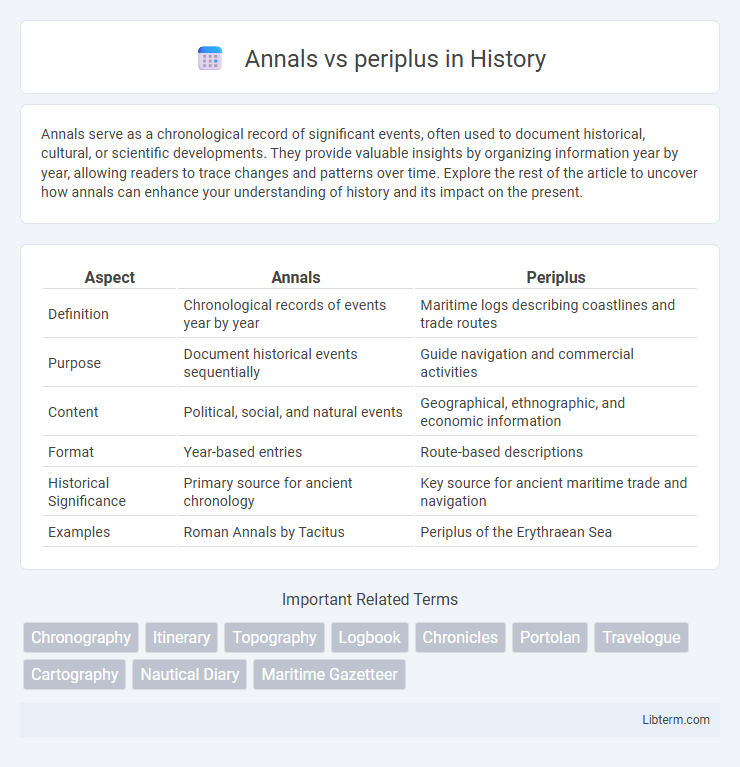Annals serve as a chronological record of significant events, often used to document historical, cultural, or scientific developments. They provide valuable insights by organizing information year by year, allowing readers to trace changes and patterns over time. Explore the rest of the article to uncover how annals can enhance your understanding of history and its impact on the present.
Table of Comparison
| Aspect | Annals | Periplus |
|---|---|---|
| Definition | Chronological records of events year by year | Maritime logs describing coastlines and trade routes |
| Purpose | Document historical events sequentially | Guide navigation and commercial activities |
| Content | Political, social, and natural events | Geographical, ethnographic, and economic information |
| Format | Year-based entries | Route-based descriptions |
| Historical Significance | Primary source for ancient chronology | Key source for ancient maritime trade and navigation |
| Examples | Roman Annals by Tacitus | Periplus of the Erythraean Sea |
Definition of Annals
Annals are historical records organized chronologically, often detailing significant events year by year to provide a continuous timeline. Unlike periplus, which is a navigational manuscript describing coastal landmarks and sea routes, annals emphasize a systematic and factual documentation of political, social, or military occurrences. This chronological structuring makes annals essential for understanding historical progressions and contextual developments over time.
Definition of Periplus
The Periplus is an ancient maritime guide detailing coastlines, harbors, and trading ports, offering practical navigation information for sailors and merchants. Unlike the Annals, which are chronological historical records focused on yearly events, the Periplus emphasizes geographic and commercial data essential for navigation and trade in antiquity. It serves as a crucial source for understanding ancient maritime routes and economic interactions across the Mediterranean and beyond.
Historical Origins of Annals
Annals originated in ancient Rome as chronological records documenting yearly events, serving as official state histories maintained by pontiffs and magistrates. These yearly entries provided a structured timeline of political, military, and religious occurrences, distinguishing annals from narrative histories by their concise, date-focused format. The Annals' format influenced subsequent historical writing by emphasizing a systematic, year-by-year approach to recording history, contrasting with the thematic or exploratory style found in works like the Periplus, which focused on maritime trade routes and geographic descriptions.
Historical Origins of Periplus
The Periplus, an ancient maritime guide, originated as practical navigational records created by Greek and Roman merchants to document coastal landmarks, ports, and trading routes across the Mediterranean and Red Seas. Unlike Annals, which are chronological historical records focusing on significant events year by year, the Periplus emphasizes geographic and commercial information essential for maritime trade and exploration. This distinction highlights the Periplus's role in facilitating early economic exchanges and cross-cultural interactions during antiquity.
Structure and Format: Annals vs Periplus
Annals typically follow a chronological structure, recording events year by year to provide a sequential historical account. Periplus, in contrast, adopts a navigational format, describing coastal landmarks, ports, and maritime routes in the order a sailor would encounter them. This fundamental difference highlights the annals' emphasis on temporal progression versus the periplus's focus on geographic and practical orientation.
Primary Purposes and Uses
Annals primarily serve as chronological records focusing on yearly events, enabling historians to track political, social, and cultural developments over time with precision. Periplus, on the other hand, functions as a navigational and commercial guide detailing coastal geography, trade routes, and ports, essential for merchants and sailors in ancient maritime navigation. While annals emphasize temporal documentation for historical analysis, peripli provide practical information for economic and exploratory purposes in the ancient world.
Geographic Focus and Scope
Annals primarily emphasize chronological records of events with broad geographic coverage spanning multiple regions and empires over extended periods. Periplus texts focus on detailed descriptions of coastlines, ports, and maritime routes, providing precise geographic information crucial for navigation and trade in specific localities. While annals offer a temporal framework for historical developments across vast territories, peripli deliver spatially concentrated data critical for understanding ancient commerce and coastal geography.
Key Examples in Ancient Literature
The Annals, exemplified by Tacitus's *Annals*, provide detailed chronological records of Roman history, emphasizing political events and imperial reigns. In contrast, periplus texts such as the *Periplus of the Erythraean Sea* offer navigational and commercial information about coastal regions, detailing ports, trade goods, and maritime routes. Key examples highlight the Annals' role in historiography, while the periplus serves as a crucial source for understanding ancient trade and geography.
Influence on Later Historical Writings
The Annals provided a structured, year-by-year chronological framework that shaped the methodology of later historians by emphasizing precise dating and political events. In contrast, the Periplus, with its descriptive accounts of geography and trade routes, influenced historical writings by contributing detailed ethnographic and commercial information essential for understanding ancient economies and cultural exchanges. Together, these works enriched subsequent historiography by combining chronological rigor with comprehensive descriptions of the ancient world.
Comparative Analysis: Annals vs Periplus
Annals document chronological historical events in a year-by-year format, emphasizing political and social developments, while Periplus serves as a nautical guide detailing coastal landmarks, trade routes, and ports primarily for maritime navigation. Annals provide a broad temporal narrative aimed at recording historical progress, whereas Periplus offers practical geographic and commercial information targeting merchants and sailors. The comparative analysis reveals Annals prioritize historical chronology and political context, contrasted by Periplus's focus on spatial orientation and economic interactions along maritime corridors.
Annals Infographic

 libterm.com
libterm.com